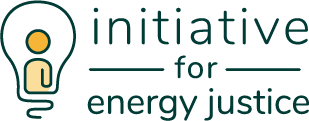Getting into the weeds for the grassroots
Communities are developing solutions for a just transition to an equitable and renewable energy economy. The Initiative for Energy Justice works to bring these visions into reality by providing concrete law and policy resources to advocates and policymakers.
Read IEJ’s new report, Justice in 100 Report
What is energy justice?
Energy justice refers to the goal of achieving equity in both the social and economic participation in the energy system, while also remediating social, economic, and health burdens on those disproportionately harmed by the energy system. Energy justice explicitly centers the concerns of communities at the frontline of pollution and climate change (“frontline communities”), working class people, indigenous communities, and those historically disenfranchised by racial and social inequity. Energy justice aims to make energy accessible, affordable, clean, and democratically managed for all communities.
What We Do
Energy Policy Research — We provide advocates and policymakers with equity-centered legal, policy, and quantitative research. The needs of frontline advocates and policymakers inform our research questions. We root our research in specific policy areas, as well as place..
Tools & Training — We offer a range of energy policy and legislative models, as well as transactional tools for the design and structure of energy projects. We also work with frontline partners and policymakers to promote accessibility and understanding of these tools.
Partnership-Based Consulting — Our team assists partners with the design and implementation of energy justice policy, community energy projects, and regulatory advocacy.
Policy/Issue Areas
Access to Energy
Having access not only to renewable energy, but even being connected to an electrical grid at all, is still an issue for many people, particularly in rural areas and for tribal nations. In addition, communities that do have access to electricity are increasingly facing power outages from disasters or even preemptive shutoffs to prevent wildfires. Within this realm, there is a growing movement to consider energy as a human right to ensure affordable access to renewable energy to every single person. To learn more, check out our California Public Safety Power Shutoffs Policy Brief Series and the accompanying webinar, our Utility Shutoffs and the COVID-19 Pandemic Policy Brief. and our Energy Justice in Climate Change Adaptation for Western States Policy Brief.
Utility Structure
In the U.S., the primary model of electricity provision is to carve up geographic territories and allow one utility to operate a regulated monopoly in that region. Yet, with the transition to renewables that can be cleaner and more decentralized, stakeholders are questioning these conventional business models and exploring alternatives such as community choice aggregation, municipal utilities, and integrating other innovative players and approaches into the market. To learn more, check out our Utilities 101 guide, slide deck, and video.
Community Solar
Community solar (or community energy) refers to various approaches to cooperatively generating renewable energy. It is often seen as an alternative to households and business who for one reason or another cannot access rooftop solar. Typically community solar entails offsite, but nearby, generation of electricity that multiple electricity customers share. Equitable community solar also considers issues such as community ownership and control of such resources and whether all communities are fairly accessing and benefiting from projects.
Net Energy Metering/Value of Solar
In most states, net energy metering (NEM) represents a straightforward policy mechanism to encourage rooftop solar by crediting electric customers for any solar energy they produce on their bill. NEM typically refers to a model where the monetary value of this credit is the same as the retail rate the customer would otherwise pay for electricity. Some states are replacing a retail rate NEM credit with a specifically calculated “value of solar” rate that may or may not properly incentivize customers and developers, which poses a risk for an equitable and rapid renewables transition.
100% Renewable Energy Policies
A growing number of cities and states are setting aggressive goals to shift to renewable energy — including a push for reaching or nearing 100% of energy coming from renewable sources. Yet there are many potential pathways for how such goals are achieved in different sectors, including buildings and transportation, as well as how the associated benefits and burdens of this transition play out, particularly for historically disenfranchised communities. To learn more, check out the Justice in 100: Scorecard for evaluating clean energy laws, and the accompanying Justice in 100 Metrics report.
Partners & Funders




